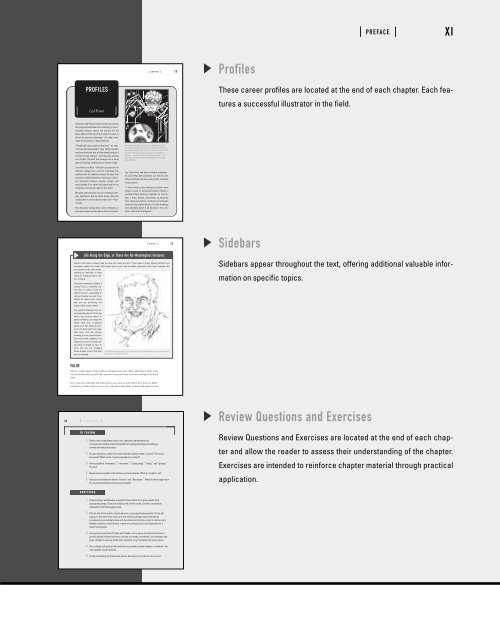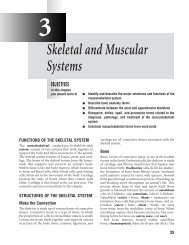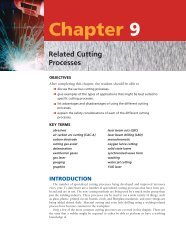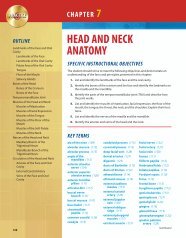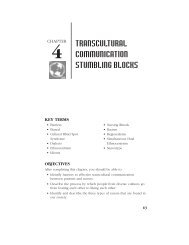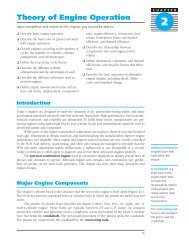Exploring Illustration - Delmar Learning
Exploring Illustration - Delmar Learning
Exploring Illustration - Delmar Learning
You also want an ePaper? Increase the reach of your titles
YUMPU automatically turns print PDFs into web optimized ePapers that Google loves.
fle26210_fm.qxd 9/30/03 2:37 PM Page XI<br />
78<br />
PROFILES<br />
Led Pants<br />
Illustrator Led Pants asserts that he must work<br />
his unique sensibilities into a drawing or that illustration<br />
always comes out too dry for his<br />
taste. Much of the Led Pants style, he says, is<br />
driven by personal ideology—it’s what motivates<br />
the illustrator to keep drawing.<br />
“People talk about style all the time,” he says.<br />
“I’m not really interested in ‘style.’ What interests<br />
me about the visual arts is what people bring to it<br />
in terms of their politics—how they see society<br />
and all that. The stuff that enrages me is what<br />
gets me drawing. I really have to react to things.”<br />
Led works on a Mac—which he equates to the<br />
ultimate collage tool—and his technique has<br />
evolved with his digital prowess. He says that<br />
working in Adobe Illustrator means you will favor<br />
geometric shapes, precise curves, and<br />
sharp angles; it’s a style really optimized for the<br />
computer, and exactly right for this artist.<br />
Recently Led has been doing increasingly complex<br />
illustration. But he starts these elaborate<br />
visuals with a profoundly low-tech tool—Postit<br />
notes.<br />
The illustrator writes down a list of objects or<br />
scenes he wants to take place within the draw-<br />
VALUE<br />
| CHAPTER 1 |<br />
Illustrator Led Pants works on a Macintosh, and<br />
uses Adobe Illustrator almost exclusively. Led gets<br />
a number of high-tech clients and does a lot of stuff<br />
for kids. This obviously has much to do with his<br />
process—what he calls “that modern look”—as<br />
well as a sense of humor decidedly left-of-center.<br />
(© Led Pants)<br />
ing. From here, Led doesn’t sketch anything—<br />
he just draws the situations out one by one.<br />
When satisfied with the result, he fits it into the<br />
larger picture.<br />
“I draw things pretty finalized and then move<br />
things around. In illustrations where there’s a<br />
problem fitting elements together on one image,<br />
I draw pieces individually as separate<br />
files. I then group them, cut them out, and paste<br />
them into my original picture. I do the drawings<br />
and ultimately patch it all directly in the computer,<br />
right into the program.”<br />
| CHAPTER 2 |<br />
Life Along the Edge, or There Are No Meaningless Gestures<br />
Gesture and contour drawing help you deal with mass and form. These types of marks quickly establish and<br />
strengthen spatial and shape relationships (part to part, part to whole), especially when figure drawing. Not<br />
everybody has the same understanding<br />
or definition of what<br />
makes for a gestural line or contour<br />
drawing.<br />
You might be tempted to define a<br />
contour line as a glorified outline.<br />
But an outline is only the<br />
shell of the form—the outside. In<br />
contour drawing, we seek to establish<br />
the whole form—inside<br />
and out—by perceiving the<br />
edges of that subject matter.<br />
Yes, gesture drawings also encompass<br />
the edge, but that’s not<br />
where your process starts. In<br />
gesture drawing, you target the<br />
whole (3-D) form. A gesture<br />
study is not flat. Gesture drawing<br />
is not about vertical or diagonal<br />
lines. And like contour<br />
drawing, it is not about the shell.<br />
One way to look at gesture is to<br />
imagine your pencil actually laying<br />
down a length of yarn or<br />
wire, and you are wrapping<br />
these strands around the form John Rutherford’s portrait of John Madden is a fine example of a strong gestural line<br />
you are drawing.<br />
approach. (© John Rutherford)<br />
Value is a relative degree of the darkness and lightness in color. Often called tone or shade, value<br />
is an extraordinarily powerful and expressive tool, particularly if you are working in black and<br />
white.<br />
Every color beyond black and white has its own value as well. And in fact, there are different<br />
degrees of value within any one color. Take those beautifully rendered red apples in your<br />
| the subject matters |<br />
in review<br />
1. Define, then relate these terms: non-objective/representational;<br />
conceptual/narrative; advertising/editorial; collage/montage/assemblage;<br />
comics/cartoons/caricature.<br />
2. In your estimation, what is the most relevant subject matter concern? The most<br />
prevalent? What venue or genre appeals to you least?<br />
3. What classifies “alternative,” “new wave,” “cutting edge,” “fringe,” and “grunge”<br />
for you?<br />
4. Name some examples of illustration you find extreme. What is “modern” art?<br />
5. Discuss and debate the labels “fine art” and “illustration.” What do these tags mean<br />
for you professionally and to you personally?<br />
exercises<br />
1. Choose a topic and develop a specific theme. Work from a live model. Find<br />
appropriate props. Pose your subject and set the scene. Create a conceptual<br />
illustration from this staged scene.<br />
2. Pick an old cliché and do a fresh, dynamic, conceptual interpretation of that old<br />
saying. In the same vein: work up a fast moving montage about something<br />
considered excruciatingly slow and mundane (paint drying, a snail in motion, etc.)<br />
Another variation on this theme: create an exciting book cover illustration for a<br />
rather boring book.<br />
3. Do a series of portraits of family and friends or do a series of self-portraits over a<br />
specific period of time (one hour, one day, one week, one month, one semester, one<br />
year). Variation: use one media only. Variation: vary the media with every piece.<br />
4. Do a collage self-portrait that involves no personal, private imagery or artifacts. Use<br />
only outside, found elements.<br />
5. Create something mechanical by nature, but organic at heart (or vice versa).<br />
33<br />
19<br />
Profiles<br />
These career profiles are located at the end of each chapter. Each features<br />
a successful illustrator in the field.<br />
Sidebars<br />
Sidebars appear throughout the text, offering additional valuable information<br />
on specific topics.<br />
Review Questions and Exercises<br />
# 41921 Cust: <strong>Delmar</strong> Au: Fleishman Pg No XI K<br />
| PREFACE |<br />
Review Questions and Exercises are located at the end of each chapter<br />
and allow the reader to assess their understanding of the chapter.<br />
Exercises are intended to reinforce chapter material through practical<br />
application.<br />
XI


